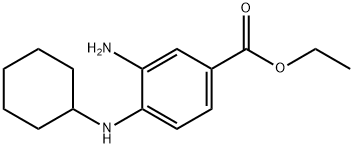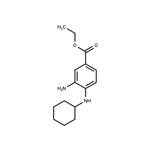Description
Ferrostatin-1 (347174-05-4) inhibits ferroptosis (EC50=60 nM), an iron-dependent form of nonapoptotic cell death.1?Potent inhibitor of ferroptosis in cancer cells and glutamate-induced cell death in organotypic rat brain slices.1?Blocks the cytotoxic effects of sorafenib in hepatocellular carcinoma cells.2?Ferrostatin-1 inhibits oxidative lipid damage and cell death in diverse disease models3 and prevents apoptosis of renal proximal tubular cells induced by reactive oxygen species4.
Uses
Ferrostatin-1 (Fer-1) is a potent and selective inhibitor of ferroptosis.
Definition
ChEBI: Ferrostatin-1 is an ethyl ester resulting from the formal condensation of the carboxy group of 3-amino-4-(cyclohexylamino)benzoic acid with ethanol. It is a potent inhibitor of ferroptosis, a distinct non-apoptotic form of cell death caused by lipid peroxidation. It is also a radical-trapping antioxidant and has the ability to reduce the accumulation of lipid peroxides and chain-carrying peroxyl radicals. It has a role as a ferroptosis inhibitor, a radiation protective agent, an antioxidant, a radical scavenger, an antifungal agent and a neuroprotective agent. It is a substituted aniline, an ethyl ester and a primary arylamine.
Biochem/physiol Actions
Ferrostatin-1 is an active radical-trapping antioxidant that traps peroxyl radicals, and thus serves as a potential inhibitor of ferroptosis. Ferroptosis is considered as regulated necrosis, which differs from apoptosis and autophagy. Ferrostatin-1 is known to show protective effects against Huntington′s disease and also prevents neurotoxicity induced by glutamate in cellular models.
References
1) Dixon et al. (2012), Ferroptosis: an iron-dependent form of nonapoptotic cell death; Cell, 149 1060
2) Louandre et al. (2013), Iron-dependent cell death of hepatocellular carcinoma cells exposed to sorafenib; Int. J. Cancer, 133 1732
3) Skouta et al. (2014), Ferrostatins inhibit oxidative lipid damage and cell death in diverse disease models; J. Am. Chem. Soc., 136 4551
4) Nowak et al. (2013), Protein kinase C-α interaction with iHSP70 in mitochondria promotes recovery of mitochondrial function after injury in renal proximal tubular cells; Am. J. Physiol. Renal. Physiol., 305 F764



